Mirella Sichirollo Patzer's Blog, page 46
January 16, 2012
The Room with a Beehive by Comizia Bellocchi Scoccianti (Author) and Patrizia Argentieri (Translator)
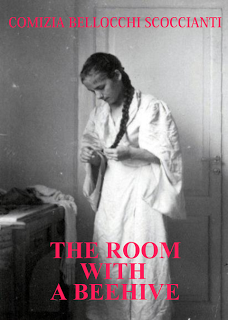 An ancient world full of values and traditions gives way to a new society. During the difficult change, accentuated by the climate of World War II, a young woman firmly tackles life challenges with inventive, initiative and disarming grace. This true story is refreshing and poetic, inspirational and stirring.
An ancient world full of values and traditions gives way to a new society. During the difficult change, accentuated by the climate of World War II, a young woman firmly tackles life challenges with inventive, initiative and disarming grace. This true story is refreshing and poetic, inspirational and stirring. The Room with a Beehive is a family memoir that is set in the small Italian town, Le Marche, before and after World War II. It is a fascinating chronicle of day-to-day life when times were less complicated and more tranquil. What I found most fascinating was how people in the village seemed more like family than neighbors, where they were self-sufficient and people helped people. One of my favourite parts of the book describes how they raised silkworms to make their own silk that was considered superior to that of China.
As the memoir progresses, the author takes us through the events leading to World War II, the shortage of food and supplies, and how they managed to survive despite the vast numbers of men who were called to arms and the hardships born by the women left behind.
I found myself fascinated with the story because it brought to life the era in which my own parents lived in Italy and their stories about how they survived the horrendous events that affected their lives during the war. It swept me back to a simple time, where people depended and trusted each other for help and support. Lush with vividly detailed descriptions about people, places, food, and items, this book provided wonderful insight into Italian daily village life. This book is definitely a must read – especially for readers with Italian roots.
I LOVE COMMENTS










Published on January 16, 2012 08:48
Fanny Fern - Shame the Devil by Debra Brenegan
Fanny Fern - A wickedly outspoken author!
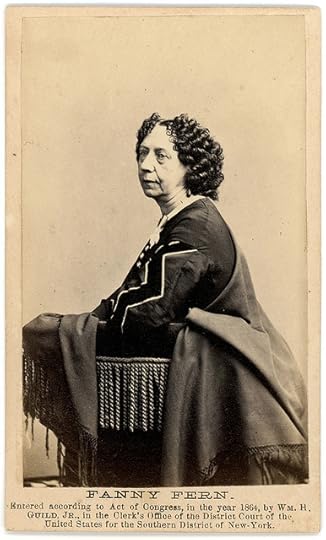
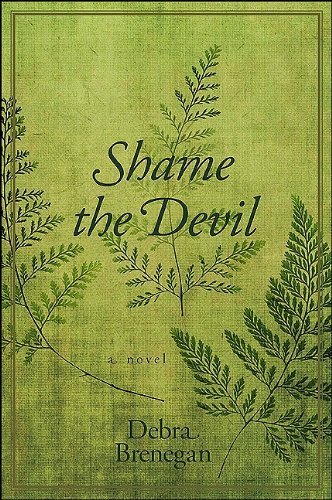
Shame the Devil is based upon the remarkable and true story of 19th century novelist, journalist, and feminist, Fanny Fern, also known as Sara Payson Willis (1811 – 1872). She was born in Portland Maine. Her father, Nathaniel Willis, owned a newspaper. Early on, she chose the pen name of Fanny Fern because it reminded her of her mother as she picked ferns.
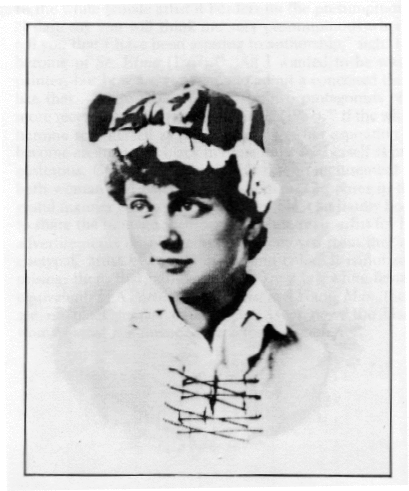 She attended a boarding school in Hartford Connecticut where she was dubbed as one of te worst behaved but most beloved girls. In 1837 she married Charles Harrington Eldredge, a banker. Fanny bore him three daughters. Tragedy struck eight years later when her eldest daughter died of meningitis and her husband died of typhoid fever. Willis was left nearly destitute. With little help from either her father or her in-laws or her brother, she struggled to support herself and her two surviving daughters. Her father encouraged her to remarry as a means to solve their financial difficulties.
She attended a boarding school in Hartford Connecticut where she was dubbed as one of te worst behaved but most beloved girls. In 1837 she married Charles Harrington Eldredge, a banker. Fanny bore him three daughters. Tragedy struck eight years later when her eldest daughter died of meningitis and her husband died of typhoid fever. Willis was left nearly destitute. With little help from either her father or her in-laws or her brother, she struggled to support herself and her two surviving daughters. Her father encouraged her to remarry as a means to solve their financial difficulties.
So in 1849, she married a merchant by the name of Samuel Farrington. Right from the start, they faced difficulties due to her husband's intense jealousy. Two years later, she left him, creating a scandal and divorced him.
On her own and with two daughters to support, Fanny began to write in earnest, publishing articles. She sent samples of her work under her own name to her brother Nathaniel, who owned a magazine, but he refused them and said her writing was not marketable. She kept her identity hidden as her abusive ex-husband continued to make strife by spreading vicious rumours. But this didn't stop Fanny. Her work was accepted by newspapers and journals in New York where she wrote a witty column that proved highly popular.
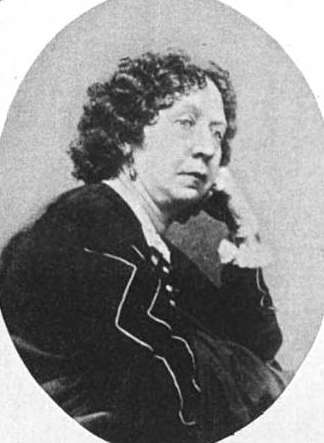
In the 1850's a children's novel she wrote sold 70,000 copies in its first year, quite an achievement for the times. James Parton, editor for the Home Journal, a magazine owned by Fanny's brother, published her columns. But when her brother discovered this, he forbade Parton from publishing any more of Fern's work. In protest, Parton resigned.
Fanny's first book, Fern Leaves (1853), was a best seller. It sold 46,000 copies in the first four months, and over 70,000 copies the first year. With her royalties, she bought a house in Brooklyn and lived comfortably well. She soon became the highest paid columnist in the U.S.
Fern wrote about her happy first marriage, the poverty she endured after he died and lack of help from male relatives, and her struggle to achieve financial independence as a journalist. She did not hesitate to write unflattering portrayals of those who had treated her uncharitably when she most needed help, including her father, her in-laws, her brother N.P. Willis, and two newspaper editors. When Fern's identity was revealed shortly after the novel's publication, some critics believed it scandalous that she had attacked her own relatives; they decried her lack of filial piety and her want of "womanly gentleness" in such characterizations.
Author Nathaniel Hawthorne praised her work. He said, "...enjoyed it a great deal. The woman writes as if the devil was in her, and that is the only condition in which a woman ever writes anything worth reading."
Fanny died of cancer in 1872.
Author Debra Brenegan did an exceptional job writing this inspiring and engrossing biography. She not only writes with very vivid detail, but she did so in a way that truly made Fanny and her surroundings seem real. It is a poignant story of the struggles women faced to survive in a world where few opportunities existed.
This is a really, really great book.
Here is a brief sample of her sarcastic and sometimes vitriolic writing. This piece is entitled, I Can't.
I CAN'T
APOLLO!—what a face! Doleful as a hearse; folded hands; hollow chest; whining voice; the very picture of cowardly irresolution. Spring to your feet, hold up your head, set your teeth together, draw that fine form of yours up to the height that God made it; draw an immense long breath, and look about you. What do you see? Why, all creation taking care of number one;—pushing ahead like the car of Juggernaut, over live victims. There it is; and you can't help it. Are you going to lie down and be crushed?
By all that is manly, no!—dash ahead! You have as good a right to mount the triumphal car as your neighbor. Snap your fingers at croakers. If you can't get round a stump, leap over it, high and dry. Have nerves of steel, a will of iron. Never mind sideaches, or heartaches, or headaches,—dig away without stopping to breathe, or to notice envy or malice. Set your target in the clouds, and aim at it. If your arrow falls short of the mark, what of that? Pick it up and go at it again. If you should never reach it, you will shoot higher than if you only aimed at a bush. Don't whine, if your friends fall off. At the first stroke of good luck, by Mammon! they will swarm around you like a hive of bees, till you are disgusted with human nature. "I can't!" O, pshaw! I throw my glove in your face, if I am a woman! You are a disgrace to corduroys. What! a man lack courage? A man want independence? A man to be discouraged at obstacles? A man afraid to face anything on earth, save his Maker? Why! I have the most unmitigated contempt for you, you little pusillanimous pussy-cat! There is nothing manly about you, except your whiskers.
I LOVE COMMENTS












Shame the Devil is based upon the remarkable and true story of 19th century novelist, journalist, and feminist, Fanny Fern, also known as Sara Payson Willis (1811 – 1872). She was born in Portland Maine. Her father, Nathaniel Willis, owned a newspaper. Early on, she chose the pen name of Fanny Fern because it reminded her of her mother as she picked ferns.
 She attended a boarding school in Hartford Connecticut where she was dubbed as one of te worst behaved but most beloved girls. In 1837 she married Charles Harrington Eldredge, a banker. Fanny bore him three daughters. Tragedy struck eight years later when her eldest daughter died of meningitis and her husband died of typhoid fever. Willis was left nearly destitute. With little help from either her father or her in-laws or her brother, she struggled to support herself and her two surviving daughters. Her father encouraged her to remarry as a means to solve their financial difficulties.
She attended a boarding school in Hartford Connecticut where she was dubbed as one of te worst behaved but most beloved girls. In 1837 she married Charles Harrington Eldredge, a banker. Fanny bore him three daughters. Tragedy struck eight years later when her eldest daughter died of meningitis and her husband died of typhoid fever. Willis was left nearly destitute. With little help from either her father or her in-laws or her brother, she struggled to support herself and her two surviving daughters. Her father encouraged her to remarry as a means to solve their financial difficulties. So in 1849, she married a merchant by the name of Samuel Farrington. Right from the start, they faced difficulties due to her husband's intense jealousy. Two years later, she left him, creating a scandal and divorced him.
On her own and with two daughters to support, Fanny began to write in earnest, publishing articles. She sent samples of her work under her own name to her brother Nathaniel, who owned a magazine, but he refused them and said her writing was not marketable. She kept her identity hidden as her abusive ex-husband continued to make strife by spreading vicious rumours. But this didn't stop Fanny. Her work was accepted by newspapers and journals in New York where she wrote a witty column that proved highly popular.

In the 1850's a children's novel she wrote sold 70,000 copies in its first year, quite an achievement for the times. James Parton, editor for the Home Journal, a magazine owned by Fanny's brother, published her columns. But when her brother discovered this, he forbade Parton from publishing any more of Fern's work. In protest, Parton resigned.
Fanny's first book, Fern Leaves (1853), was a best seller. It sold 46,000 copies in the first four months, and over 70,000 copies the first year. With her royalties, she bought a house in Brooklyn and lived comfortably well. She soon became the highest paid columnist in the U.S.
Fern wrote about her happy first marriage, the poverty she endured after he died and lack of help from male relatives, and her struggle to achieve financial independence as a journalist. She did not hesitate to write unflattering portrayals of those who had treated her uncharitably when she most needed help, including her father, her in-laws, her brother N.P. Willis, and two newspaper editors. When Fern's identity was revealed shortly after the novel's publication, some critics believed it scandalous that she had attacked her own relatives; they decried her lack of filial piety and her want of "womanly gentleness" in such characterizations.
Author Nathaniel Hawthorne praised her work. He said, "...enjoyed it a great deal. The woman writes as if the devil was in her, and that is the only condition in which a woman ever writes anything worth reading."
Fanny died of cancer in 1872.
Author Debra Brenegan did an exceptional job writing this inspiring and engrossing biography. She not only writes with very vivid detail, but she did so in a way that truly made Fanny and her surroundings seem real. It is a poignant story of the struggles women faced to survive in a world where few opportunities existed.
This is a really, really great book.
Here is a brief sample of her sarcastic and sometimes vitriolic writing. This piece is entitled, I Can't.
I CAN'T
APOLLO!—what a face! Doleful as a hearse; folded hands; hollow chest; whining voice; the very picture of cowardly irresolution. Spring to your feet, hold up your head, set your teeth together, draw that fine form of yours up to the height that God made it; draw an immense long breath, and look about you. What do you see? Why, all creation taking care of number one;—pushing ahead like the car of Juggernaut, over live victims. There it is; and you can't help it. Are you going to lie down and be crushed?
By all that is manly, no!—dash ahead! You have as good a right to mount the triumphal car as your neighbor. Snap your fingers at croakers. If you can't get round a stump, leap over it, high and dry. Have nerves of steel, a will of iron. Never mind sideaches, or heartaches, or headaches,—dig away without stopping to breathe, or to notice envy or malice. Set your target in the clouds, and aim at it. If your arrow falls short of the mark, what of that? Pick it up and go at it again. If you should never reach it, you will shoot higher than if you only aimed at a bush. Don't whine, if your friends fall off. At the first stroke of good luck, by Mammon! they will swarm around you like a hive of bees, till you are disgusted with human nature. "I can't!" O, pshaw! I throw my glove in your face, if I am a woman! You are a disgrace to corduroys. What! a man lack courage? A man want independence? A man to be discouraged at obstacles? A man afraid to face anything on earth, save his Maker? Why! I have the most unmitigated contempt for you, you little pusillanimous pussy-cat! There is nothing manly about you, except your whiskers.
I LOVE COMMENTS










Published on January 16, 2012 07:56
January 10, 2012
The Crown by Nancy Bilyeau
[image error]
A fascinating mystery about an ancient crown of King Athelstan's!
Synopsis:
An aristocratic young nun must find a legendary crown in order to save her father—and preserve the Catholic faith from Cromwell's ruthless terror. The year is 1537. . .
Joanna Stafford, a Dominican nun, learns that her favorite cousin has been condemned by Henry VIII to be burned at the stake. Defying the sacred rule of enclosure, Joanna leaves the priory to stand at her cousin's side. Arrested for interfering with the king's justice, Joanna, along with her father, is sent to the Tower of London.
The ruthless Stephen Gardiner, Bishop of Winchester, takes terrifying steps to force Joanna to agree to spy for him: to save her father's life she must find an ancient relic—a crown so powerful, it may hold the ability to end the Reformation. Accompanied by two monks, Joanna returns home to Dartford Priory and searches in secret for this long-lost piece of history worn by the Saxon King Athelstan in 937 during the historic battle that first united Britain.
But Dartford Priory has become a dangerous place, and when more than one dead body is uncovered, Joanna departs with a sensitive young monk, Brother Edmund, to search elsewhere for the legendary crown. From royal castles with tapestry-filled rooms to Stonehenge to Malmesbury Abbey, the final resting place of King Athelstan, Joanna and Brother Edmund must hurry to find the crown if they want to keep Joanna's father alive. At Malmesbury, secrets of the crown are revealed that bring to light the fates of the Black Prince, Richard the Lionhearted, and Katherine of Aragon's first husband, Arthur. The crown's intensity and strength are beyond the earthly realm and it must not fall into the wrong hands.
With Cromwell's troops threatening to shutter her priory, bright and bold Joanna must now decide who she can trust with the secret of the crown so that she may save herself, her family, and her sacred way of life. This provocative story melds heart-stopping suspense with historical detail and brings to life the poignant dramas of women and men at a fascinating and critical moment in England's past.
Review:
Believable characters, heart-wrenching scenes, and a strong determined heroine named Joanna Stafford make this a very engrossing read. Author Nancy Bilyeau has penned a fascinating story set during the Henry the VIII's reign when angry at the Catholic Church, he he dissolved monasteries and religious houses, scattering nuns and priests throughout the country. Although the novel is set during the Tudor period, it is not about the Tudors. Rather, it is a historical mystery that centers around a fascinating search for a crown. I very much enjoyed the historical facts surrounding King Athelstan and the crown, the ancient relic that once belonged to him.
The plot had plenty of intrigue and emotion. I enjoyed the characters, especially the nuns who were not always what I expected and made wonderful antagonists. Excellent writing, plenty of historical detail to really make the era come alive, and a tale with enough twists and turns to keep me reading to the very end. For those who are tired of the Tudors but love the era, this book is perfect. A truly enjoyable story well put together! There is a sequel, and I eagerly await it!
I LOVE COMMENTS










Synopsis:
An aristocratic young nun must find a legendary crown in order to save her father—and preserve the Catholic faith from Cromwell's ruthless terror. The year is 1537. . .
Joanna Stafford, a Dominican nun, learns that her favorite cousin has been condemned by Henry VIII to be burned at the stake. Defying the sacred rule of enclosure, Joanna leaves the priory to stand at her cousin's side. Arrested for interfering with the king's justice, Joanna, along with her father, is sent to the Tower of London.
The ruthless Stephen Gardiner, Bishop of Winchester, takes terrifying steps to force Joanna to agree to spy for him: to save her father's life she must find an ancient relic—a crown so powerful, it may hold the ability to end the Reformation. Accompanied by two monks, Joanna returns home to Dartford Priory and searches in secret for this long-lost piece of history worn by the Saxon King Athelstan in 937 during the historic battle that first united Britain.
But Dartford Priory has become a dangerous place, and when more than one dead body is uncovered, Joanna departs with a sensitive young monk, Brother Edmund, to search elsewhere for the legendary crown. From royal castles with tapestry-filled rooms to Stonehenge to Malmesbury Abbey, the final resting place of King Athelstan, Joanna and Brother Edmund must hurry to find the crown if they want to keep Joanna's father alive. At Malmesbury, secrets of the crown are revealed that bring to light the fates of the Black Prince, Richard the Lionhearted, and Katherine of Aragon's first husband, Arthur. The crown's intensity and strength are beyond the earthly realm and it must not fall into the wrong hands.
With Cromwell's troops threatening to shutter her priory, bright and bold Joanna must now decide who she can trust with the secret of the crown so that she may save herself, her family, and her sacred way of life. This provocative story melds heart-stopping suspense with historical detail and brings to life the poignant dramas of women and men at a fascinating and critical moment in England's past.
Review:
Believable characters, heart-wrenching scenes, and a strong determined heroine named Joanna Stafford make this a very engrossing read. Author Nancy Bilyeau has penned a fascinating story set during the Henry the VIII's reign when angry at the Catholic Church, he he dissolved monasteries and religious houses, scattering nuns and priests throughout the country. Although the novel is set during the Tudor period, it is not about the Tudors. Rather, it is a historical mystery that centers around a fascinating search for a crown. I very much enjoyed the historical facts surrounding King Athelstan and the crown, the ancient relic that once belonged to him.
The plot had plenty of intrigue and emotion. I enjoyed the characters, especially the nuns who were not always what I expected and made wonderful antagonists. Excellent writing, plenty of historical detail to really make the era come alive, and a tale with enough twists and turns to keep me reading to the very end. For those who are tired of the Tudors but love the era, this book is perfect. A truly enjoyable story well put together! There is a sequel, and I eagerly await it!
I LOVE COMMENTS










Published on January 10, 2012 17:21
A beautiful tale of conquest and a fall of the great empi...
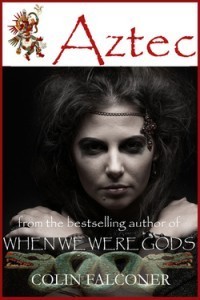 A beautiful tale of conquest and a fall of the great empire. Book Description:
A beautiful tale of conquest and a fall of the great empire. Book Description:The daughter of a prophet and the child slave of Spanish adventurer Hernan Cortes, the life of the Aztec princess Malinali is one of the most enduring legends of Mexico. Her role in history divides opinion even today. Reviled by some as a traitor responsible for the destruction of the Indians, worshiped by others as a heroine and symbolic mother of the nation, hers is the most extraordinary story in the history of the Americas.
The legendary Aztec civilization is here brought to life in blazing colour, as the author traces the story of the enigmatic Malinali who held for a moment the future of an entire country in her hands. Contradictory, sensuous and fiercely intelligent, Malinali became the key to Cortes' conquest of Mexico. It is a story of impossible odds, unimaginable cruelty, extraordinary courage, and craven betrayal. Who were the heroes and who the villains?
Today the Aztecs are a distant memory. But Malinali's name lives on. This book spent four months on the bestseller lists in Mexico, re-igniting debate yet again about the true heritage of a people and the very nature of western colonization of the natural world. My Review: In the novel AZTEC, Spanish conquistador, Hernán Cortés, leads an expedition into Mexico to bring it under the rule of the King of Castile during the early 1500's. He encounters a young, courageous slave woman named Malinali who was an once an Aztec princess sold into slavery to the Mayans when she was a child. Malinali becomes an interpreter and guide and consort to Cortés on his journey to speak to the greatest leader of Mexico. This book is a remarkable novel, not only for its fascinating historical details, but because author Colin Falconer holds nothing back in recounting the pagan brutality and horrendous cruelties of this exotic land and time. He brings the legendary character of Malinali to life. She stands out as a paragon, a woman of virtue and enigmatic strength who will definitely appeal to feminine readers. Although there is a romantic element between Malinali and Cortés, it does not overpower the story. Rather, it acts as a comfort, soothing the reader's mood after some of the more shocking, brutal scenes. A fast-paced read, Aztec fascinated me from start to finish. As with all of Colin Falconer's novels, his characters have depth and credibility, moving the story forward through their often unpredictable actions. His work takes the reader through a never-ending labyrinth of twists and turns that grips and entertains. You must get this book. It is a magnificent piece of work! I LOVE COMMENTS










Published on January 10, 2012 15:55
January 9, 2012
An Affair with Mr Kennedy by Jillian Stone
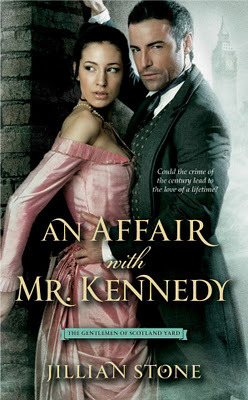 A thrilling Victorian mystery and a very sexy couple!
A thrilling Victorian mystery and a very sexy couple!Back Cover Blurb:
London, 1887. Part stoic gentleman, part fearless Yard man, Zeno "Zak" Kennedy is an enigma of the first order. For years, the memory of a deadly bombing at King's Cross has haunted the brilliant Scotland Yard detective. His investigation has zeroed in on a ring of aristocratic rebels whose bloody campaign for Irish revolution is terrorizing the city. When he discovers one of the treacherous lords is acquainted with his free-spirited new tenant, Cassandra St. Cloud, his inquiry pulls him unexpectedly close to the heart of the conspiracy—and into the arms of a most intriguing lady. Cassie is no Victorian prude. An impressionist painter with very modern ideas about life and love, she is eager for a romantic escapade that is daring and discreet. She sets her sights on her dour but handsome landlord, but after she learns their meeting was not purely accidental, she hardly has a chance to forgive her lover before their passionate affair catapults them both into a perilous adventure.
Part Victorian romance and part mystery thriller, An Affair with Mr Kennedy by author Jillian Stone has plenty of plot to keep a reader interested and reading. The hero of the story is Zeno, a detective with Scotland Yard. Smart and private, Zeno is determined to solve a crime that has haunted him for years – the deadly bombing at the King's Cross station in London.
He encounters Cassie, his new tenant, a gutsy and bold beauty who balks at the mores and strictness of the Victorian society, which binds her. Instantly, their attraction begins, binding them together as the secrets of this who-dun-it are revealed.
First, I enjoy novels set in the Victorian period. What makes this story really stand out is the sexual tension between Cassie and Zeno as they face one challenge after another. The plot had lots of fun twists and turns. It was an easy book to read and culminated in a very satisfying ending. For anyone who loves a cozy mystery and intriguing, well-written romance, than this is definitely a book you must read. Loads of fun and entertainment!
You can pre-order the book at Amazon
I LOVE COMMENTS










Published on January 09, 2012 16:21
January 6, 2012
Off to Save the World: How Julia Taft Made a Difference by Ann Blackman
An exciting new book about a fascinating humanitarian!
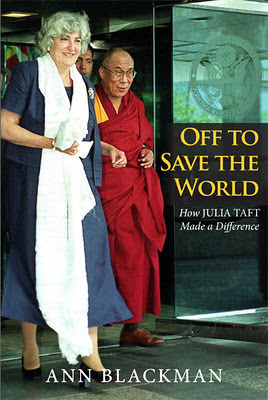 "This book is an eloquent and informative testament to Julia Taft, a heroic, indefatigable, and prodigiously effective champion of refugees and other victims of natural and man-made disasters. In capturing the essence, the scope, and the spirit of Julia's lifework and legacy, Ann Blackman has brought to bear her prodigious reportorial and narrative skill, along with an intimate personal knowledge of Julia. The result is a labor of love and a fitting tribute to a remarkable individual and to the entire field of humanitarian activism."-Strobe Talbott, President, Brookings Institution
"This book is an eloquent and informative testament to Julia Taft, a heroic, indefatigable, and prodigiously effective champion of refugees and other victims of natural and man-made disasters. In capturing the essence, the scope, and the spirit of Julia's lifework and legacy, Ann Blackman has brought to bear her prodigious reportorial and narrative skill, along with an intimate personal knowledge of Julia. The result is a labor of love and a fitting tribute to a remarkable individual and to the entire field of humanitarian activism."-Strobe Talbott, President, Brookings Institution
"The story of Julia Taft should serve as an inspiration to us. This vibrant and funny woman never stood by daunted by the size of the world's problems or the stubbornness of its politicians. Instead, she stepped up whenever she saw people in need—whether it be survivors of natural disasters, victims of atrocities, sufferers from famines and disease, refugees from wars —and found a way to help them. With admiration and amusement, Ann Blackman tells the story of her friend and extended family member who changed the way the United States responds to disasters, proving that one person truly can make a difference in thousands, if not millions, of lives. " -Cokie Roberts, Senior news analyst, ABC News, National Public Radio and trustee of Save the Children
OFF TO SAVE THE WORLD: How Julia Taft Made a DifferenceBy Ann Blackman_________________________________________________
http://www.offtosavetheworld.com/
For more than three decades, Julia Taft was one of the United States' top humanitarian relief experts, friend and ally of the world's most impoverished people. She was, simply put, a legend in her field.
In OFF TO SAVE THE WORLD: How Julia Taft Made a Difference (Maine Authors Publishing, November 1, 2011) veteran journalist and author Ann Blackman paints a mosaic of a witty, determined and idealistic woman who not only ran some of the most dramatic relief efforts of her generation, but also influenced the debate at home as the international spotlight moved from Vietnam, Cambodia and Laos to the collapse of the Soviet Union to ethnic conflicts in Africa and the former Yugoslavia.
"At a time when undeveloped countries are overwhelmed by refugee problems and people in the developed world are struggling with the consequences of immigration, Taft's story deserves to be told," Blackman said. Taft, who married into a famous Republican family, dedicated herself to restoring honor and dignity to those far less fortunate than herself. Starting in 1975 when she was 32 years old, Taft directed the task force that managed the resettlement of refugees from the Vietnam War. Over the years, she basically invented the way the United States government responds to natural and man-made disasters around the world. She also directed:
• The American relief effort during the Armenian earthquake.• Operation Lifeline Sudan.• Harrowing refugee relief missions during the siege of Sarajevo and the crisis in Kosovo.• The United Nations task force that coordinated the recovery effort in Afghanistan after the fall of the Taliban government in 2001.
Blackman also describes Taft's fascinating and enduring friendship with the Dalai Lama, whom shemet in 1999 when she was the State Department's coordinator for Tibetan issues. His Holiness counseled Taft when she was battling cancer.
There are poignant stories and funny ones, heroic moments and terrifying ones, all woven into an emotional and adventurous life. There was no one like Julia Taft.
###
Ann Blackman is the author of Seasons of Her Life, a biography of Madeleine Korbel Albright (Scribner/Simon & Schuster, 1998) and co-author of The Spy Next Door The Extraordinary Secret Life of Robert Philip Hanssen, about the FBI agent who spied for the Russians, (Little Brown, 2002.) She is also the author of Wild Rose, a biography of Civil War spy Rose O'Neale Greenhow (Random House, 2005.)
Blackman worked at TIME magazine and The Associated Press, specializing in reporting about the life of the nation's power brokers and their families. She has appeared on TV and radio shows including A&E Biography, Washington Week in Review, The Diane Rehm Show, Hardball with Chris Matthews, CNN, Fox Morning News, The Charlie Rose Show, Book Notes/CSPAN, The Hill, To the Best of Our Knowledge and The Jim Bohannon Show. She lives in Washington, DC, and on the coast of Maine.
OFF TO SAVE THE WORLD by Ann BlackmanOn sale: November 1, 2011/ Hardcover $24.95, softcover $12.95Also available as an eBook $4.99.www.Offtosavetheworld.com.
Advance Praise Includes:
"Julia was the real All-American. Leading humanitarian operations from the front, never taking no for an answer but then racing home to be mother and wife, Ann Blackman has captured a Julia that personified the very best of her country." -Mark Malloch-Brown, former Deputy Secretary-General, United Nations.
"Julia Taft was one of a kind. Ann Blackman has captured this extraordinary woman with a passion that equals her passionate personality. She brought a voice, a commitment and tireless purpose to our cause, making US NGOs a force to be reckoned with in policy circles." -William S. Reese, President and CEO, International Youth Foundation
"Everyone who knows Julia Taft has a favorite "Julia story" and Off to Save the World is a treasure chest of stories about an incredible individual whose passion, wit, and charm empowered people impacted by disasters worldwide. I had the privilege to work with and learn from Julia and will be using the chapters detailing Julia's involvement with Operation Lifeline Sudan, the Armenian Earthquake, the War in Bosnia, etc., as case studies that illuminate the qualities of leaders in the humanitarian field for our students in the Master of Science in Disaster Resilience Leadership program at Tulane University." -Ky Luu, Executive Director, Disaster Resilience Leadership Academy, Tulane University
"Julia Taft was a consummate humanitarian whose intelligence, openness, and deep caring for the world's most vulnerable people will continue to be sorely missed. Ann Blackman has written a highly entertaining and very enlightening book about Julia's unusually productive life. We need more books like this and more people like Julia Taft."-Ron Waldman, Founding Director, Program on Forced Migration and Health, Mailman School of Public Health Columbia University
I LOVE COMMENTS










 "This book is an eloquent and informative testament to Julia Taft, a heroic, indefatigable, and prodigiously effective champion of refugees and other victims of natural and man-made disasters. In capturing the essence, the scope, and the spirit of Julia's lifework and legacy, Ann Blackman has brought to bear her prodigious reportorial and narrative skill, along with an intimate personal knowledge of Julia. The result is a labor of love and a fitting tribute to a remarkable individual and to the entire field of humanitarian activism."-Strobe Talbott, President, Brookings Institution
"This book is an eloquent and informative testament to Julia Taft, a heroic, indefatigable, and prodigiously effective champion of refugees and other victims of natural and man-made disasters. In capturing the essence, the scope, and the spirit of Julia's lifework and legacy, Ann Blackman has brought to bear her prodigious reportorial and narrative skill, along with an intimate personal knowledge of Julia. The result is a labor of love and a fitting tribute to a remarkable individual and to the entire field of humanitarian activism."-Strobe Talbott, President, Brookings Institution "The story of Julia Taft should serve as an inspiration to us. This vibrant and funny woman never stood by daunted by the size of the world's problems or the stubbornness of its politicians. Instead, she stepped up whenever she saw people in need—whether it be survivors of natural disasters, victims of atrocities, sufferers from famines and disease, refugees from wars —and found a way to help them. With admiration and amusement, Ann Blackman tells the story of her friend and extended family member who changed the way the United States responds to disasters, proving that one person truly can make a difference in thousands, if not millions, of lives. " -Cokie Roberts, Senior news analyst, ABC News, National Public Radio and trustee of Save the Children
OFF TO SAVE THE WORLD: How Julia Taft Made a DifferenceBy Ann Blackman_________________________________________________
http://www.offtosavetheworld.com/
For more than three decades, Julia Taft was one of the United States' top humanitarian relief experts, friend and ally of the world's most impoverished people. She was, simply put, a legend in her field.
In OFF TO SAVE THE WORLD: How Julia Taft Made a Difference (Maine Authors Publishing, November 1, 2011) veteran journalist and author Ann Blackman paints a mosaic of a witty, determined and idealistic woman who not only ran some of the most dramatic relief efforts of her generation, but also influenced the debate at home as the international spotlight moved from Vietnam, Cambodia and Laos to the collapse of the Soviet Union to ethnic conflicts in Africa and the former Yugoslavia.
"At a time when undeveloped countries are overwhelmed by refugee problems and people in the developed world are struggling with the consequences of immigration, Taft's story deserves to be told," Blackman said. Taft, who married into a famous Republican family, dedicated herself to restoring honor and dignity to those far less fortunate than herself. Starting in 1975 when she was 32 years old, Taft directed the task force that managed the resettlement of refugees from the Vietnam War. Over the years, she basically invented the way the United States government responds to natural and man-made disasters around the world. She also directed:
• The American relief effort during the Armenian earthquake.• Operation Lifeline Sudan.• Harrowing refugee relief missions during the siege of Sarajevo and the crisis in Kosovo.• The United Nations task force that coordinated the recovery effort in Afghanistan after the fall of the Taliban government in 2001.
Blackman also describes Taft's fascinating and enduring friendship with the Dalai Lama, whom shemet in 1999 when she was the State Department's coordinator for Tibetan issues. His Holiness counseled Taft when she was battling cancer.
There are poignant stories and funny ones, heroic moments and terrifying ones, all woven into an emotional and adventurous life. There was no one like Julia Taft.
###
Ann Blackman is the author of Seasons of Her Life, a biography of Madeleine Korbel Albright (Scribner/Simon & Schuster, 1998) and co-author of The Spy Next Door The Extraordinary Secret Life of Robert Philip Hanssen, about the FBI agent who spied for the Russians, (Little Brown, 2002.) She is also the author of Wild Rose, a biography of Civil War spy Rose O'Neale Greenhow (Random House, 2005.)
Blackman worked at TIME magazine and The Associated Press, specializing in reporting about the life of the nation's power brokers and their families. She has appeared on TV and radio shows including A&E Biography, Washington Week in Review, The Diane Rehm Show, Hardball with Chris Matthews, CNN, Fox Morning News, The Charlie Rose Show, Book Notes/CSPAN, The Hill, To the Best of Our Knowledge and The Jim Bohannon Show. She lives in Washington, DC, and on the coast of Maine.
OFF TO SAVE THE WORLD by Ann BlackmanOn sale: November 1, 2011/ Hardcover $24.95, softcover $12.95Also available as an eBook $4.99.www.Offtosavetheworld.com.
Advance Praise Includes:
"Julia was the real All-American. Leading humanitarian operations from the front, never taking no for an answer but then racing home to be mother and wife, Ann Blackman has captured a Julia that personified the very best of her country." -Mark Malloch-Brown, former Deputy Secretary-General, United Nations.
"Julia Taft was one of a kind. Ann Blackman has captured this extraordinary woman with a passion that equals her passionate personality. She brought a voice, a commitment and tireless purpose to our cause, making US NGOs a force to be reckoned with in policy circles." -William S. Reese, President and CEO, International Youth Foundation
"Everyone who knows Julia Taft has a favorite "Julia story" and Off to Save the World is a treasure chest of stories about an incredible individual whose passion, wit, and charm empowered people impacted by disasters worldwide. I had the privilege to work with and learn from Julia and will be using the chapters detailing Julia's involvement with Operation Lifeline Sudan, the Armenian Earthquake, the War in Bosnia, etc., as case studies that illuminate the qualities of leaders in the humanitarian field for our students in the Master of Science in Disaster Resilience Leadership program at Tulane University." -Ky Luu, Executive Director, Disaster Resilience Leadership Academy, Tulane University
"Julia Taft was a consummate humanitarian whose intelligence, openness, and deep caring for the world's most vulnerable people will continue to be sorely missed. Ann Blackman has written a highly entertaining and very enlightening book about Julia's unusually productive life. We need more books like this and more people like Julia Taft."-Ron Waldman, Founding Director, Program on Forced Migration and Health, Mailman School of Public Health Columbia University
I LOVE COMMENTS










Published on January 06, 2012 19:24
January 2, 2012
Conjuigal Rights
Published on January 02, 2012 17:14
December 30, 2011
The Printmaker's Daughter by Katherine Govier
[image error]
A fascinating novel about a woman artist in Edo Japan
Summary
Recounting the story of her life, Oei plunges us into the colourful world of nineteenth-century Edo, in which courtesans rub shoulders with poets, warriors consort with actors, and the arts flourish in an unprecedented moment of creative upheaval. Oei and Hokusai live among writers, novelists, tattoo artists, and prostitutes, evading the spies of the repressive shogunate as they work on Hokusai's countless paintings and prints. Wielding her brush, rejecting domesticity in favour of dedication to the arts, Oei defies all expectations of womanhood—all but one. A dutiful daughter to the last, she will obey the will of her eccentric father, the man who created her and who, ultimately, will rob her of her place in history.
Vivid, daring, and unforgettable, The Printmaker's Daughter shines fresh light on art, loyalty, and the tender and indelible bond between a father and daughter.
Set in 19th century Japan, the Edo period, The Printmaker's Daughter is a fascinating rendering of life's hardships for Japanese women and artists in that era. Oei is the favourite daughter of her famous master painter artist father, Hokusai. Despite Hokusai's fame, his family was truly poor. Born to him late in life, she immediately enchanted him because of her aptitude for art and her vivid personality, unusual for Japanese women. When he leaves his family to pursue his art, he takes his favourite child with him. Despite the restrictions imposed on her, she served as a dutiful business partner to her father, keeping his accounts, helping his students, and even secretly completing some of his art projects. He struggled against strict government control and strong sentiments against artists. He took his daughter along with him in his travels, leaving her in the care of courtesans in the pleasure district so he could work. Oei struggles to find a balance between honing her talent as an artist and learning the womanly household arts expected of a young woman in such a strict culture. She also grapples with her allegiance to a father she equally resents is sometimes repulsed by – a man truly selfish in his pursuits with poor appreciation for the Oei's own sacrifices.
In this dual biographical historical novel about Oei and Hokusai's lives, readers will experience rich details of Japanese life. Told in first person narrative through Oei's point of view, this is a beautifully written and well-researched story. As with most biographical historical novels, I did find the pace slow at various points in the story. This is normal and to be expected; after all, true life is not always filled with constant turmoil and conflict. Therefore, readers should understand this and enjoy the story for what it is - an accurate portrayal of two struggling artists who left an indelible mark upon history, art, and culture in Japan. The novel describes a world far removed from that which we know in the West.
Oei's story is one of dauntless courage to overcome cultural restrictions for women of the time. Through beautiful prose, the writer evokes emotion and I could not help becoming fascinated with this exotic story, especially when given glimpses into the brothel life and prostitution.
The Printmaker's Daughter was published in Canada as The Ghost Brush.
I LOVE COMMENTS










Summary
Recounting the story of her life, Oei plunges us into the colourful world of nineteenth-century Edo, in which courtesans rub shoulders with poets, warriors consort with actors, and the arts flourish in an unprecedented moment of creative upheaval. Oei and Hokusai live among writers, novelists, tattoo artists, and prostitutes, evading the spies of the repressive shogunate as they work on Hokusai's countless paintings and prints. Wielding her brush, rejecting domesticity in favour of dedication to the arts, Oei defies all expectations of womanhood—all but one. A dutiful daughter to the last, she will obey the will of her eccentric father, the man who created her and who, ultimately, will rob her of her place in history.
Vivid, daring, and unforgettable, The Printmaker's Daughter shines fresh light on art, loyalty, and the tender and indelible bond between a father and daughter.
Set in 19th century Japan, the Edo period, The Printmaker's Daughter is a fascinating rendering of life's hardships for Japanese women and artists in that era. Oei is the favourite daughter of her famous master painter artist father, Hokusai. Despite Hokusai's fame, his family was truly poor. Born to him late in life, she immediately enchanted him because of her aptitude for art and her vivid personality, unusual for Japanese women. When he leaves his family to pursue his art, he takes his favourite child with him. Despite the restrictions imposed on her, she served as a dutiful business partner to her father, keeping his accounts, helping his students, and even secretly completing some of his art projects. He struggled against strict government control and strong sentiments against artists. He took his daughter along with him in his travels, leaving her in the care of courtesans in the pleasure district so he could work. Oei struggles to find a balance between honing her talent as an artist and learning the womanly household arts expected of a young woman in such a strict culture. She also grapples with her allegiance to a father she equally resents is sometimes repulsed by – a man truly selfish in his pursuits with poor appreciation for the Oei's own sacrifices.
In this dual biographical historical novel about Oei and Hokusai's lives, readers will experience rich details of Japanese life. Told in first person narrative through Oei's point of view, this is a beautifully written and well-researched story. As with most biographical historical novels, I did find the pace slow at various points in the story. This is normal and to be expected; after all, true life is not always filled with constant turmoil and conflict. Therefore, readers should understand this and enjoy the story for what it is - an accurate portrayal of two struggling artists who left an indelible mark upon history, art, and culture in Japan. The novel describes a world far removed from that which we know in the West.
Oei's story is one of dauntless courage to overcome cultural restrictions for women of the time. Through beautiful prose, the writer evokes emotion and I could not help becoming fascinated with this exotic story, especially when given glimpses into the brothel life and prostitution.
The Printmaker's Daughter was published in Canada as The Ghost Brush.
I LOVE COMMENTS










Published on December 30, 2011 14:50
December 26, 2011
Lucrezia Borgia (1480 - 1519)
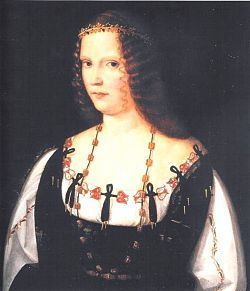 Lucrezia Borgia
Lucrezia BorgiaPainting by Bartolomeo Veneziano
Twenty-eleven was a good year for the Borgias, who were depicted in not one but two television shows. In fact, I was bored at home with Netflix one night when I decided to watch Jeremy Irons play Rodrigo in Showtime's The Borgias, only to discover that the show on Netflix was not The Borgias but Borgia, an entirely separate show produced by Canal Plus.
Neither show is for the faint of heart, as stories about the Borgia are generally told with a sneer or a blush. Lucrezia's life was none too pious and, as with many women of the era, she was played like a chess piece by the men in her family. This is not to say, of course, that Lucrezia didn't have a few tricks of her own—namely the rumored empty ring on her hand she often filled with poison.
The Fairest of All
Rumors riddle Lucrezia's biography, but certain things are clear: she was born in 1480 an illegitimate daughter of Rodrigo Borgia, later the corrupt Pope Alexander VI.
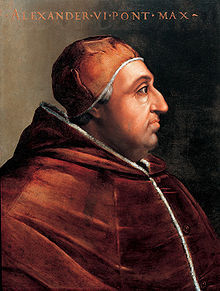 Pope Alexander VI
Pope Alexander VIShe bedazzled onlookers with her hazel eyes, perfect complexion, and waves of golden hair that fell past her knees as she walked gracefully down the aisle with her first husband Giovanni Sforza.
 Lucrezia Borgia
Lucrezia Borgia Giovanni SforzaCondottiere and Lord of Pesaro and Gradara
Giovanni SforzaCondottiere and Lord of Pesaro and GradaraThe marriage was more an alliance—when Rodrigo became Pope Alexander VI, he needed strong allies like the Sforza family, even if it meant annulling Lucrezia's previous engagement to a lord in Valencia.
The Unconsummated Marriage
Eventually, the pope no longer needed the Sforzas. While many theories abound regarding the divorce, it is generally accepted that when the pope ordered Giovanni's quiet execution, Cesare informed his sister and Lucrezia convinced her husband to flee Rome.
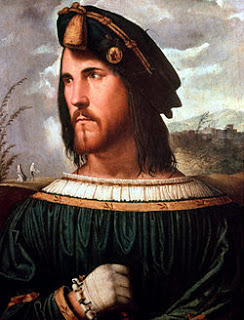 Cesare Borgia
Cesare Borgia Another popular (and perhaps juicier) rumor, however, is that Cesare and Lucrezia were having an incestuous affair and Giovanni simply needed eliminating, even if it meant putting words into the pope's mouth. Either way, the pope claimed the marriage had not been consummated, that it was invalid, and that his daughter was free to "choose" her next husband, never mind that she was supposedly pregnant at the time of the annulment.
The Fruit of Said Unconsummated Marriage
Lucrezia awaited the divorce at the convent of San Sisto and there, before her marriage to Alfonso of Aragon, allegedly gave birth to a son named Giovanni, known today as Roman Infante. It was not long before two papal bulls were issued concerning little Giovanni, neither of them mentioning Lucrezia as his mother—one, that he was Cesare's child from an affair before his marriage, and another that Giovanni was Pope Alexander's child. It was assumed at the time that Giovanni's was Cesare's brood, but Giovanni later stayed with Lucrezia in Ferrara, where he was accepted as her half-brother.
 Giovanni Borgia
Giovanni BorgiaA Pearl Among Women
When her second husband died, Lucrezia was handed to Alfonso d'Este, Duke of Ferrara, with whom she had numerous children and besides whom she had many extramarital affairs.
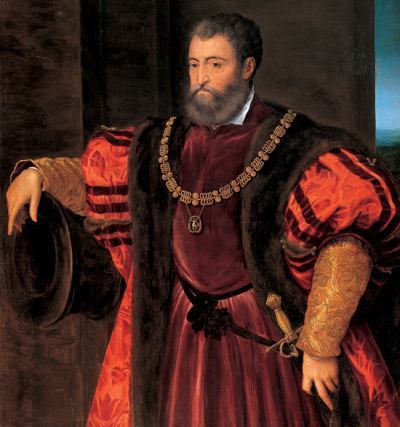 Alfonso d'Este
Alfonso d'EsteThese included her married brother-in-law, who later contracted syphilis and kindly ended matters with Lucrezia, as well as the noted French soldier, the Chevalier Bayard, who described her as a "pearl among women."
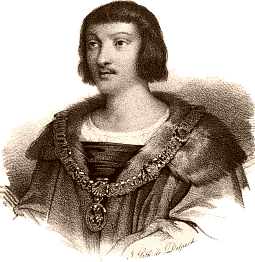 Chevalier Bayard
Chevalier BayardLucrezia died in October 1519 at the age of 39 after the complicated birth of her eight child and buried in the convent of Corpus Domini. Her legacy—beauty, incest, murder, passionate affairs, and perhaps above all courage, or rather nerve—is one that fascinates historians, storytellers, and gossips alike. She did, after all, survive the fall of the Borgias after Pope Alexander VI's death. The same cannot be said for everyone.
About the author:
Amanda Tradwick is a grant researcher and writer for CollegeGrants.org. She has a Bachelor's degrees from the University of Delaware, and has recently finished research on college grants for minorities and vermont education grants.
I LOVE COMMENTS










Published on December 26, 2011 23:51
December 25, 2011
The Birth of Jesus
The true story of Christmas
Good morning everyone! I send you my warmest wishes this Christmas morning. I hope that your day is beautiful and loving surrounded by good friends and family.
Despite the many gifts we have exchanged this morning, and amid all the commercialism we have endured this month, never forget the real reason for our celebration. Here is my gift to you.
Merry Christmas to all!
I LOVE COMMENTS










Good morning everyone! I send you my warmest wishes this Christmas morning. I hope that your day is beautiful and loving surrounded by good friends and family.
Despite the many gifts we have exchanged this morning, and amid all the commercialism we have endured this month, never forget the real reason for our celebration. Here is my gift to you.
Merry Christmas to all!
I LOVE COMMENTS










Published on December 25, 2011 06:00







